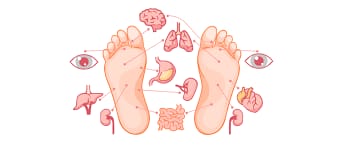
Introduction
Reflexology is a complementary therapy based on the principle that specific points on the feet, hands, and ears (known as reflex points) correspond to different organs, glands, and systems of the body. By applying pressure to these reflex points, reflexologists aim to promote relaxation, improve circulation, and support the body’s natural healing processes.
This article explores the foundational principles of reflexology, its treatment modalities, and advanced techniques used in modern practice.
1. Foundations of Reflexology
1.1 Historical Background
Reflexology dates back thousands of years, with roots in ancient Egyptian, Chinese, and Native American healing traditions. Modern reflexology was popularized in the early 20th century by Dr. William Fitzgerald (zone therapy) and later refined by Eunice Ingham, who developed the foot reflexology map.
1.2 Principles of Reflexology
- Zone Theory: The body is divided into 10 longitudinal zones (5 on each side) that correspond to reflex areas on the feet and hands.
- Reflex Points: Specific points on the feet, hands, and ears mirror organs and body systems.
- Energy Flow: Reflexology helps release blockages in energy pathways (similar to acupuncture meridians).
2. Reflexology Treatment Modalities
2.1 Foot Reflexology
The most common form, foot reflexology involves applying pressure to reflex points on the feet.
- Techniques: Thumb walking, finger walking, rotation on a point, and hook-and-backup.
- Benefits: Stress relief, improved circulation, pain reduction, and organ function support.
2.2 Hand Reflexology
Hand reflexology is useful when foot access is limited (e.g., foot injuries or sensitivities).
- Techniques: Similar to foot reflexology but adapted for smaller reflex areas.
- Benefits: Convenient for self-treatment, helps with arthritis, and reduces tension.
2.3 Ear Reflexology (Auricular Therapy)
Based on the concept that the ear is a microsystem of the body.
- Techniques: Acupressure, seed therapy, or electrical stimulation.
- Benefits: Used for addiction recovery, pain management, and stress relief.
2.4 Facial Reflexology
A newer modality mapping reflex points on the face.
- Techniques: Gentle pressure and massage techniques.
- Benefits: Anti-aging, relaxation, and sinus relief.
2.5 Meridian Reflexology
Combines reflexology with Traditional Chinese Medicine (TCM) meridians.
- Techniques: Stimulating reflex points along energy pathways.
- Benefits: Balances Qi (energy flow) and enhances organ function.
3. Advanced Reflexology Techniques
3.1 Vertical Reflex Therapy (VRT)
Developed by Lynne Booth, VRT involves working on weight-bearing feet (client in a seated or standing position).
- Application: Enhances lymphatic drainage and deep tissue stimulation.
- Conditions Treated: Edema, sports injuries, and chronic pain.
3.2 Reflexology Lymph Drainage (RLD)
A specialized technique focusing on lymphatic reflexes.
- Application: Gentle, rhythmic movements to stimulate lymph flow.
- Conditions Treated: Lymphedema, post-surgical swelling, and detoxification.
3.3 Advanced Foot Reading
Analyzing foot structure, skin texture, and calluses to assess health imbalances.
- Application: Helps identify chronic issues before they manifest physically.
3.4 Hot Stone Reflexology
Incorporates heated stones to deepen relaxation and improve circulation.
- Application: Stones are placed on reflex points or used to massage.
3.5 Electro-Reflexology
Uses low-voltage electrical stimulation on reflex points.
- Application: Enhances nerve response and pain relief.
3.6 Chromo-Reflexology
Combines reflexology with color therapy (using colored lights or filters).
- Application: Different colors correspond to specific energy centers (chakras).
3.7 Acu-Reflexology
A fusion of acupuncture and reflexology using fine needles on reflex points.
- Application: Deeper stimulation for chronic conditions.
3.8 Prenatal & Pediatric Reflexology
Adapted techniques for pregnancy and children.
- Application: Reduces pregnancy discomfort, aids digestion in infants.
4. Clinical Applications & Evidence
- Pain Management: Studies show reflexology helps with migraines, arthritis, and neuropathy.
- Stress & Anxiety: Reduces cortisol levels and promotes relaxation.
- Digestive Disorders: Improves IBS and constipation.
- Hormonal Balance: Supports menstrual and menopausal symptoms.
Conclusion
Reflexology is a versatile therapy with evolving techniques that integrate traditional knowledge with modern advancements. From basic thumb pressure to electro-stimulation and lymphatic techniques, reflexology offers a non-invasive way to enhance well-being. As research grows, its role in integrative medicine continues to expand.